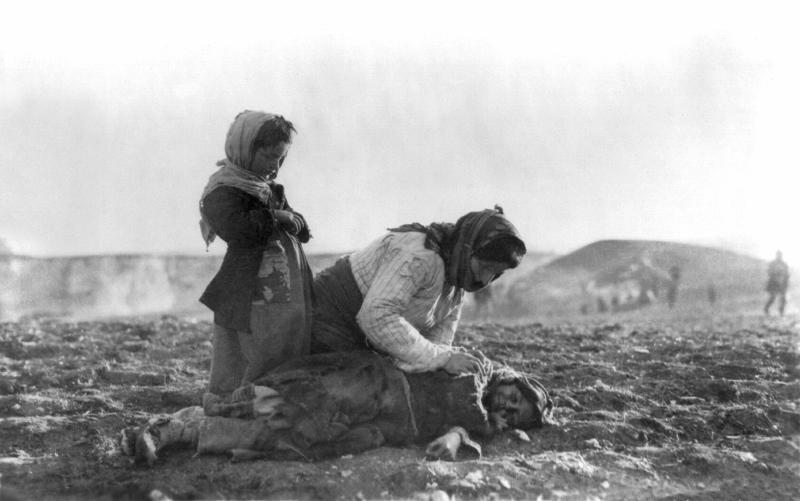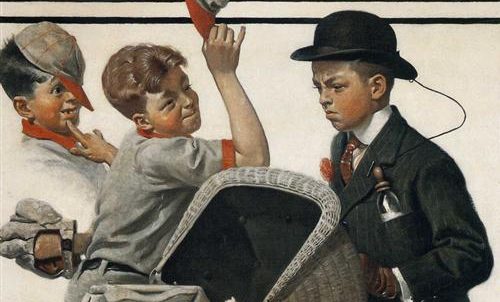It’s Everyone’s Business About the Turks: Part II
The Armenians, for most of their history, were in different states of subservience to foreign powers. They had empires and kingdoms that held their own, but for the most part, were subjected to direct, indirect, or autonomous rule from the following powers: Assyrian Empires, Babylonia, Roman/Byzantine Empire, Persian Empires, Islamic Caliphates, Mongol Empire, Mongol successor states in the Middle East, Georgia, various Turkish kingdoms and then the Ottoman Empire, and the Russian Empire. Turkish-Armenian relations really begin around 1060, as Armenia was vied for influence by the Byzantine Empire, and the rising Seljuq Empire. Eastern Armenia was under control of the Seljuqs and Western Armenia by the Byzantines. The Byzantine foreign policy in the region was aggressive, as they had local Armenian princes sell their successorship of their states to the Byzantine Emperor, so at their death, the Emperor would have control transferred to him personally. By 1060, the government at Constantinople began increasing the integration attempts, and had the prince who was still alive of the Kingdom of Ani give up his throne. The Seljuqs responded with a border raid that ended up taking the fortified city of Ani, and most of central Armenia. Though there was a temporary peace, the Battle of Manzikert in 1071 had all of Armenia and most of Anatolia under Turkish control. Some isolated Armenian provinces still held nominal loyalty to Constantinople, but were quickly absorbed into the various Anatolian Turkish kingdoms that broke off from the main Seljuq empire. The Armenian Kingdoms of Ani and Cilicia, both which regained independence before the arrival of the 1st Crusade and the power vacuum as Turkish warlord broke away from the Seljuq empire. Ani would become a vassal of Georgia in 1201, until the Mongol conquests transferred vassalage in 1236. Cilicia was a key ally to the Crusader states, and held off several Turkish attacks, and was independent until 1236, as they also become a Mongol vassal. After the Mongol Ilkhanate Empire began losing control of Anatolia and Armenia, the Egyptian Mamluk Sultanate vassalized Cilicia. The Mamluks held onto Cilicia, loosely, until 1474, when the rising Ottoman Empire conquered it.
Most Armenians were subject to Ottoman rule by the early 1500s. Ottoman rule, much like towards the Balkan Christians, was one of tolerance, though with heavy taxation (including the blood tax), coerced Turkification and conversion to Islam, and occasional massacres.
The Armenian geographical distribution was one of being a borderland contested between great powers, and that was the case with Ottomans and several Persian dynasties (Safavid Empire, Hotak dynasty, Afsharid dynasty, and finally the Qajar dynasty). There were several wars between the early 1500s to 1823, which considerable military action took place in Armenian populated areas. As a result, the Armenian population dwindled and became more isolated from each other, massing around centers such as Van, Yerevan, Erzurum, Erzincan, Bitlis, and the Cilicia region. Formerly dominated Armenian regions were opened up to Turkish and Kurdish settlement.
Armenians lived with decent autonomy, which increased with the need to reform Ottoman society as a result of ethnic rebellions, most notably the Greek independence. In 1839, a series of reforms to expand the rights of ethnic and religious minorities, with the ultimate goal of better integrating them into the empire, launched with the Hatt-i Sharif (Illustrious Rescript) and Tanzimat reforms under Sultan Abdul Mejid. The reforms would happen until 1876, and the reforms were designed to make everyone equal before the law and secularize the country. The Hatt-i Humayun (Imperial Rescript) was specifically aimed at the Christian population, which granted, in theory, equal rights of Christians to Muslims. Armenians in particular were benefited, with the apex of their autonomy being introduced in 1863, with the state approved Armenian National Council. Within the regions of significant Armenian population, Armenians ran their own local affairs. Armenians would have their own judges, prisons and trials for Armenian-Armenian disputes. Men and women were able to vote for governors, approved by the state, and local councils. Reforms in 1868 had the formation of the Judicial Council, in which of the 14 members, 2 were Armenian. The reform attempts, along with modernization attempts were met with large scale resistance from Conservative Turks, who became more nationalistic with the wars between Russia and the ethnic groups seeking independence. This made many reforms ineffective, and attempts to enforce it and modernize at the same time proved expensive. In 1875, the Empire was bankrupt.
Bankruptcy led to opportunities and power struggle between the Liberal and Conservative parties. After the death of Abdul Mejid, Abdul Aziz became the sultan in 1861, however, his luxurious lifestyle and financial mismanagement led to him being overthrown by the liberal Murad V. Murad V would work with the Liberal party to establish a constitutional monarchy, with a parliament and a new constitution. Murad V was paranoid of coup, which would have him executed. Proving incapable, his brother Abdul Hamid II was placed on the throne by the Liberal party. However, secretly Hamid II was pro-Conservative, and used the war with Russia in 1877 to roll back reforms and rule in a despotic manner. This would be a disaster for the Armenians. Russians encouraged Armenians to aid them in the Caucasian front of the 1877 war, promising better life. While Armenian help was limited, Abdul Hamid II was afraid of the eastern Anatolian provinces with large Armenian populations, becoming independent. The authoritarian nature of Hamid’s rule worried the Western European powers, who became increasingly involved with the 1875 bankruptcy.
What would become known as the Armenian Question, the major European powers, most prominently France, Russia, and England, demanded that Christian subjects were to have equal rights extended, as the reforms proved to be a farce at best. Armenians under the reforms were prosperous and were a valuable trade and craft class, however, they had little political rights. Revolutionary Armenian groups wanting independence were active, but most Armenians were loyal citizens. That changed from 1894-1897 when Hamid II had Kurdish irregular forces attack and massacre scores of Armenian villages and cities, such as in Yozgat, Erzincan/Yerzkan, Elaziǧ/Harput, Sivas/Sebastia, Marash, and Urfa. The Armenian population was demoralized, massacred, and suppressed.
The oppressive rule of Hamid II led to widespread unrest. In 1908-9, a group of pro-modernization officers, called the Young Turks, seized control of the government. The constitution and parliament were restored to full authority. Initially Hamid II accepted this change, but in secret he organized a Conservative Counter-Revolution. The revolution failed, but did result in the massacre of the Armenian population in Adana, which supported the Young Turks. The Young Turks, in general ,were supported by most minority groups, as the reinstitution of reforms and the expansion of said reforms, would secure their position and prosperity. However, the nationalistic nature of the revolution alienated radical nationalists, who saw this as a sign of increased assimilation attempts.The events of 1894-97 and the 1909 counter revolution massacre shocked Europe, and caused the major European powers to force the Ottoman Empire to institute the Armenian Reform Package, which would have the Armenian provinces divided into two groups, that would each be overseen by a western inspector general, to insure that the Armenians were treated well. The proposal was written up first discussed in 1912, and was finally implemented in early 1914. However, at the end of 1914, the Ottoman Empire joined WWI on the side of the Central Powers and abolished the reform package, as it would have Entente inspector generals. The Russians were viewed by most radical Armenians as their protectors, so were eager to aid the Russian advance on the Caucasian front. Armenians helped Russians push towards Armenians populated cities such as Trebizond, Erzerum, Erzincan, and Van. This justified the evil actions committed by the Turkish government, in the event that would become known as the Armenian genocide.
With the Caucasian front going poorly, and ample evidence of Armenian irregulars aiding the Russian advance, the military high command disarmed Armenian troops and put them into passive roles, and later, massacred them. Around Van, the Ottoman general Djevdet Bey confiscated weapons from Armenian villages, and massacred able bodied men that would be able to resist the coming deportations. Djevdet Bey arrived outside Van and demanded that Van give up all its arms, but the citizenry and militia knew that it was a ploy to have its possible defenders killed. The Armenians dug in and successfully beat back the Ottoman force after the Ottomans open fired open the city. Later, Ottoman troops and Kurdish militias were taken away from the front lines to deport the 1.6 million Armenians in the Empire, away from the front lines. The deportations were done by foot, as lines of Armenians were escorted at gunpoint into the Syrian desert without adequate supplies. The lack of supplies were on purpose, and the deportation by foot were realized as death marches. As the Russian advance had Van behind their front lines by mid 1915, 200,000 Armenians that had fled from the death marches nearby crowded the city, which before the war only had 50,000 citizens. The Russians rearmed and relieved the Armenians defenders. The defense was valiant, as the inexperienced Armenian defenders scrapped together anything they could find and stole weapons from the Turks. The victory was short, as the Ottoman forces regrouped and defeated the smaller Russian force a the Battle of Manzikert. The reorganized force was too much to handle for the the defenders, and 150,000 fled towards the modern day Armenian capital of Yerevan, of which 60,000 died. A few months later the Russians would recapture Van, which would remain in Armenian-Russian hands until mid 1918, as Russian forces abandoned the front after the Revolution of 1917.
The Armenians were joined by Assyrians in the death march. Prominent Armenian figures and intellectuals were arrested and executed. Mass burning occurred in Moosh, with 5,000 Armenians being burned alive. In the city of Trebizond before the Russian capture, had thousands of Armenian men, women and children were taken onto boats, before being thrown overboard and left to drown miles off the cost, in the Black Sea. Concentration camps were set up in Syria for any remaining survivors of the death march, where they were systematically starved and dehydrated in the hot desert. Disease was rampant as many resorted to eating off the ground and horse feces. Bodies were littered across the country side, and the stench of burned bodies emanated around the front line with Armenian populations. It is reported that the Russian army that witnessed this atrocity, was so enraged that it completely destroyed the city of Erzurum, which had by that point lost all of its Armenian citizens. Children were targeted extensively as well. Schools dominated by Armenians had their students put into a room and gassed. Armenian children who were in hospitals, or put their arbitrarily, were overdosed by drugs, and the cause of death faked. In the end, up to 1.5 million Armenians died in the genocide.
As the Ottoman Empire was losing the war, and as the Russian Empire became the Soviet Union, the power vacuum had Armenia set up its own independent state. By the end of WWI, the Ottoman Empire surrendered to the allies. In 1919, the Treaty of Sèvres gave Armenia most of the land formerly inhabited by Armenians, except Cilicia. However, the Turkish government that had signed the treaty had no authority at this point. Turkish nationals saw the Treaty of Sèvres as humiliating, and under the leadership of Mustafa Kemal, pushed back against Allied occupation. In the east, the Turkish National Liberation Movement invaded the newly independent Armenian state, in the 2 month Turkish-Armenian war. The Armenians, having half of their total group killed and lands devastated, put up a brave but futile resistance against the reorganized Turkish troops, supplied by the Soviets trying to combat Western influence. The Turks occupied Kars, expelling the Armenian population. Afterwards, the Turks invaded modern day Armenia, to force the state to give up control of Western Armenia. The weakened Armenian state would come under Soviet control shortly thereafter.
The Armenian people would bitterly had to watch as the Soviets renounced claims to formerly populated Armenian lands, and the signed the Treaty of Moscow, also know as the Treaty of Friendship and Brotherhood between the Soviets and Turks. The Armenians would have a horrible experience under the Russians, who under Stalin, were subject to deportations. When Armenia regained independence in 1990-91, tensions reemerged. The Armenian genocide is the focal point of Armenia’s national pride, and the state denial of the genocide by Turkey is adding to centuries long tensions between the Armenian and Turkish communities. Scholars in Turkey that have advocated for admitting that the events of 1914-16 were a genocide have been prosecuted and/or assassinated. Turkey threatened retaliation against any nation that recognizes the Armenian genocide. The border between Turkey and Armenia is closed, and Turkey aims to isolate Armenia politically in response to Armenia occupying the Armenian majority province in Azerbaijan, the Nagorno-Karabakh Republic. There have been attempts to normalize relations, but the issue of the Armenian genocide is key in preventing this. The strategic importance of Turkey against Russia, made many western powers recognizing the Armenian genocide impractical. The example is the US, which doesn’t officially recognize the genocide as the US has nukes in Turkey. Unlike other ethnic tensions, it isn’t just between extreme nationalists. The culture of Armenia has a lot of anti-Turkish sentiment, and Turkish culture has a lot of anti-Armenian sentiment. Normalized relations are impossible in the near future, especially as Turkey is becoming more dictatorial and nationalistic with Edorgan.












